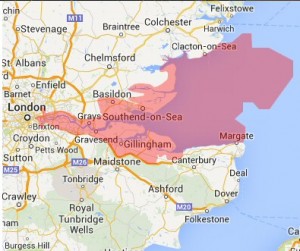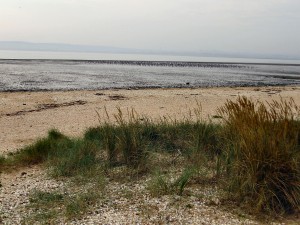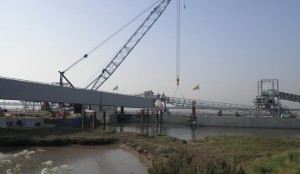I went along to the RSPB Central London Local Group to hear the RSPB project manager responsible, Jo Sampson, give a talk about the Greater Thames Futurescape.

This is the immense area (3834 km2) of the Thames estuary, including broadly all the neighbouring land up to the 5 metre contour (actually it covers all of the Isle of Grain and the Isle of Sheppey too).
Futurescape has a slightly unfortunate hokey sound to it – reminiscent of the French Futuroscope (near Poitiers), a once imaginative place with exciting architecture and a vision of the future which has turned into a sprawling business park. But the idea and the execution are very different.
There are actually a whole lot of Futurescapes around Britain; the RSPB’s contribution is to manage the Greater Thames one, and it’s a good choice, as there is a concentration of wildlife here – not least, 300,000 migrating waders – and a matching clump of RSPB nature reserves, including Cliffe Pools, Elmley Marshes (now managed by its own conservation trust), Nor Marsh and Motney Hill, Northward Hill, Old Hall Marshes, Rainham Marshes, South Essex Marshes, Shorne Marshes, Vange Marshes, Wallasea Island Wild Coast Project and West Canvey Marsh. There is also a rich sprinkling of conservation acronyms and designations across the area, with Special Protection Areas (SPA), Ramsar sites, national nature reserves and dozens of Sites of Special Scientific Interest (SSSI).
If there are so many fine, well-protected and skilfully-managed reserves in the area, why create yet another layer of management? The answer goes to the heart of the challenge to nature in a crowded place like Southeast England, and indeed in a crowded world. With a changing climate and rising sea levels, it’s always possible that a reserve, specially one down on the mud flats within a metre or two of the high tide mark, may become unsuitable for the species it was meant to protect – or may disappear altogether. If so, the wildlife will have to move to neighbouring sites, preferably suitably protected, or die out in the region.

The logic of this means that although having a reserve like Cliffe Pools that is splendid for avocets, or Elmley Marshes for waders and Marsh Harriers, is a brilliant start and very necessary, it isn’t enough. What is needed is to manage the entire landscape to make it resilient: if a shock occurs in one place, the landscape as a whole can absorb it, meaning that populations will barely fluctuate but instead simply move about. Perhaps the avocet area will turn out to be a lifeline for some other wader, or a snail, a bumblebee, or a rare pond plant.
The result is that no one organisation, not even a rich one like the RSPB – it is the largest single landowner in the Greater Thames area – can hope to do the best for nature on its own. Instead, all across the landscape, different areas, protected initially by separate organisations for their own purposes – flowers, bumblebees, birds, whatever – need to be managed together. And that means partnership, consortium, multi-organisation projects with EU funding, meetings, planning, glossy leaflets, and management-speak.
The Greater Thames area is home to a large population of humans: 6 million, not counting the similar number of Londoners who live within the area’s contour. There are powerful pressures on the land and even the mudflats below the high tide mark: housing, business, roads, bridges, railways, even mad ideas for whole new 4-runway hub airports. London mayor Boris Johnson is just the proponent of the seventh proposal in the past 50 years for a new airport in the Thames Estuary. Others (I digress, forgive me) included John Prescott’s daft attempt to put an airport on the Cliffe Pools reserve, using the Northward Hill reserve as a convenient source of spoil to spread 15 metres deep over the marshes; an earlier attempt wanted to take the Ministry of Defence’s wild seascape at Foulness, a lengthy train-ride from London. So Boris hardly invented the idea; and its dismissal for the seventh time is no guarantee that it won’t come back yet again. What is needed is enough education of the public about the value of the Thames Estuary, a vision of the future that stresses its importance to wildlife and the benefit of that wildness to us humans, so that the idea of plonking an airport in the midst of the Greater Thames land-and-waterscape sounds as ridiculous as trying to put it in Hyde Park. Prescott actually said, as he flew over (as one does) in his helicopter, clutching a map of the Southeast, “What a lot of whitespace down there”. No, it isn’t whitespace, it’s one of the best places for nature in Europe, and irreplaceable.

Since the sea level is certainly going to rise, areas are going to have to be managed actively to make them suitable for wildlife when the tide reaches higher than it does now. It isn’t enough just to breach the sea wall and gouge out pools, leaving the sea to shape mudflats, as can be done on the (rising) west coast of Britain. Huge amounts of material will have to be brought to places like Wallasea Island to turn them into wetlands and prevent them from simply vanishing beneath the waves. The RSPB has spent 10 years of patient negotiation (what a marvellous tolerance of sitting in meetings) with partners such as Crossrail, a commercial company, with the wonderful result that Crossrail will dump all the millions of tons of spoil from digging its tunnels under London at Wallasea in the Wallasea Island Wild Coast Project. Even so, more spoil is needed, and the RSPB is patiently sitting in meetings about future dredging in the Thames estuary (yeah, sounds exciting), waiting for the chance to get more mud for its nature reserves.
